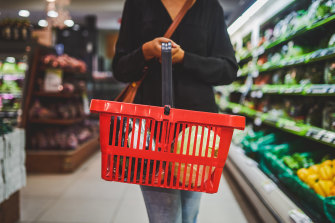It’s not just high petrol prices or construction costs driving up inflation. The cost of other essential household goods including vegetable oils, screwdrivers and cleaning products has risen sharply, and in some cases by rates not seen in 30 years or more.
Those prices are expected to keep rising over the rest of the year, as the global and local pressures on supplies and workers continue to put pressure on the price of essentials.
It is not even clear which prices are falling and which are rising.Credit:iStock
Inflation has increased 6.1 per cent over the last 12 months, according to the Australian Bureau of Statistics, driven by high construction and petrol prices. But other goods have also helped drive the consumer price index up.
Senior food retail analyst for Rabobank, Michael Harvey said food prices rose “across the grocery basket”, increasing 5.9 per cent year-on-year. It’s the highest year-on-year increase since the September quarter in 2011.
“It’s broad-based … it’s in the dairy aisles, in the meat aisle, and in bakery goods,” he said.
The cost of food oils – which includes sunflower, canola, vegetable and olive oil – increased by 14 per cent in the 12 months to June. It’s the highest rate since the ABS included food oils separately in the consumer price index. The second-highest rate was in 2002.
The Russian invasion of Ukraine has exacerbated the cost of food oil as Ukraine is one of the largest sunflower oil suppliers globally, Harvey said.
The Ukraine war has also pushed up global prices for grains, which has dragged the price of wheat up in Australia and fed through the supply chain, he said, adding to the cost of bread, which has risen by 7.2 per cent over the year – its highest rate since the December quarter 2008.
Vegetable prices, up 14.6 per cent over the last year, were affected by local challenges including floods and worker shortages, Harvey said.
“You’ve had supply disruption, but labour availability has impacted produce availability as well,” he said.
The increased cost of vegetables and meat (meat and seafood prices rose 6.3 per cent, the highest rate in 20 years) has flowed through to restaurants and fast food chains. The cost of a meal at a restaurant has gone up 5 per cent, the biggest increase since the GST was introduced in 2001, while fast food meals are up 4.6 per cent.
But it’s not just food that has risen at rates not seen for decades. The cost of furniture and furnishings has increased by 8.2 per cent, the highest rate in nearly 32 years, and the cost of home maintenance and repair, up 5.9 per cent, has not increased at that rate since 2001.
If people want to tackle that maintenance themselves, the cost of household and garden tools including drills, screwdrivers, and wheelbarrows has gone up 5.5 per cent – the biggest yearly growth rate since 1989.
Other everyday household items, including dishwashing detergents, dustpans and brooms, aluminium foil, hairbrushes and toilet paper have also become pricier. The cost of those non-durable household products rose 10.7 per cent, the highest rate since the ABS included them as a separate category at the end of 1990.
Commonwealth Bank senior economist Belinda Allen said there had been a recent trend with essential prices increasing at significantly higher rates than discretionary items, and that has continued in the latest inflation numbers.
“There remains a significant divergence in annual moves. Essential items are 7.6 per cent higher over the past year when compared to discretionary items at just 4 per cent,” she said.
This will have a bigger effect on lower-income households than higher-income earners, Allen said.
“Lower-income households devote a large share of income to essential items like food, transport and utilities,” she said.
Harvey said shoppers shouldn’t expect lower food prices for a few months yet.
“We would still think that there’s another period of high inflation numbers to come through. So consumers need to brace for that,” he said.
“Food inflation is going to be a story for another six months for consumers. This is part of a broader cost of living pressure; clearly, there’s going to be more belt-tightening from consumers in the coming months.”
Cut through the noise of federal politics with news, views and expert analysis from Jacqueline Maley. Subscribers can sign up to our weekly Inside Politics newsletter here.
Most Viewed in Politics
From our partners
Source: Read Full Article



